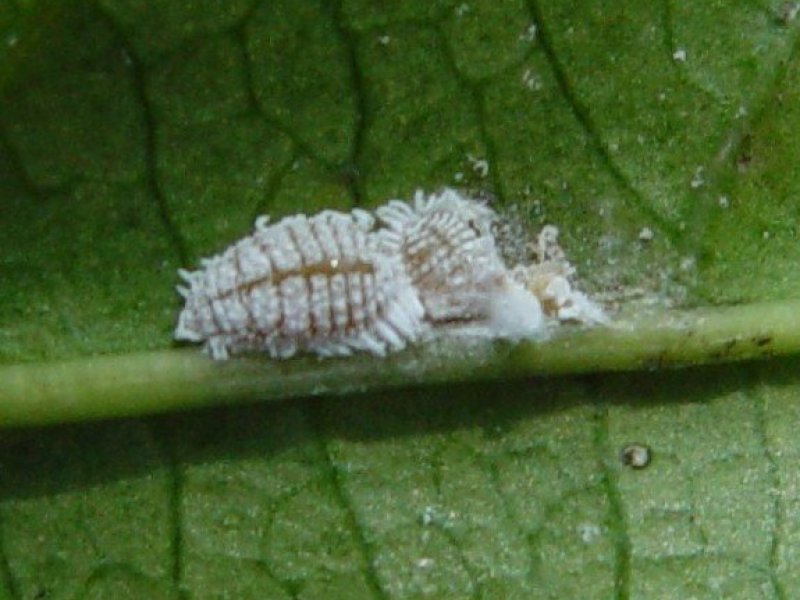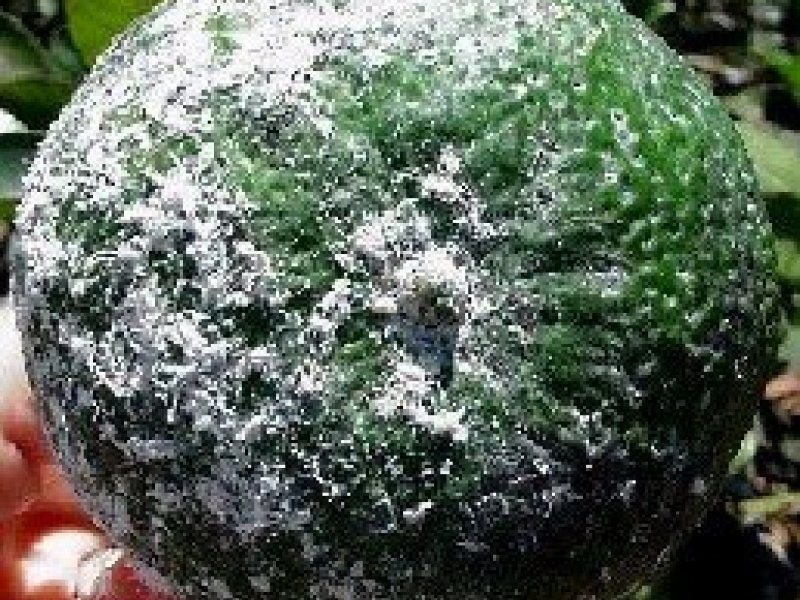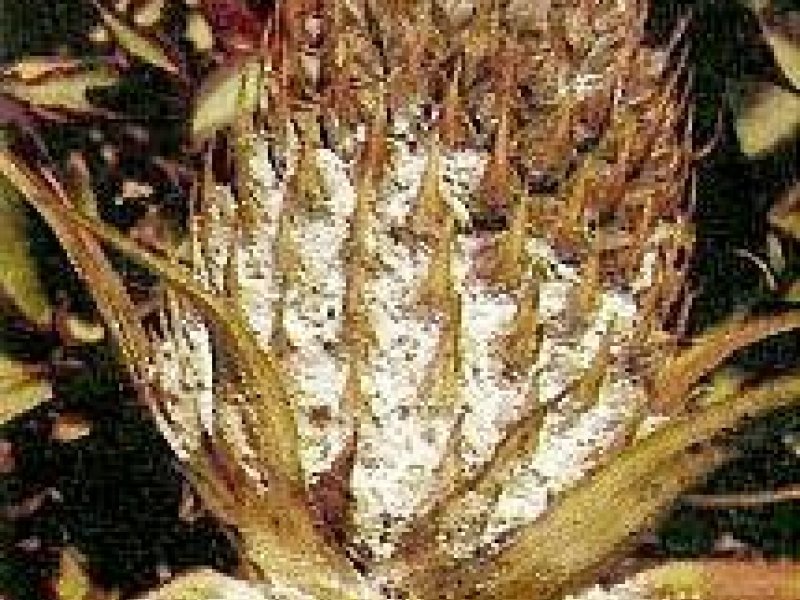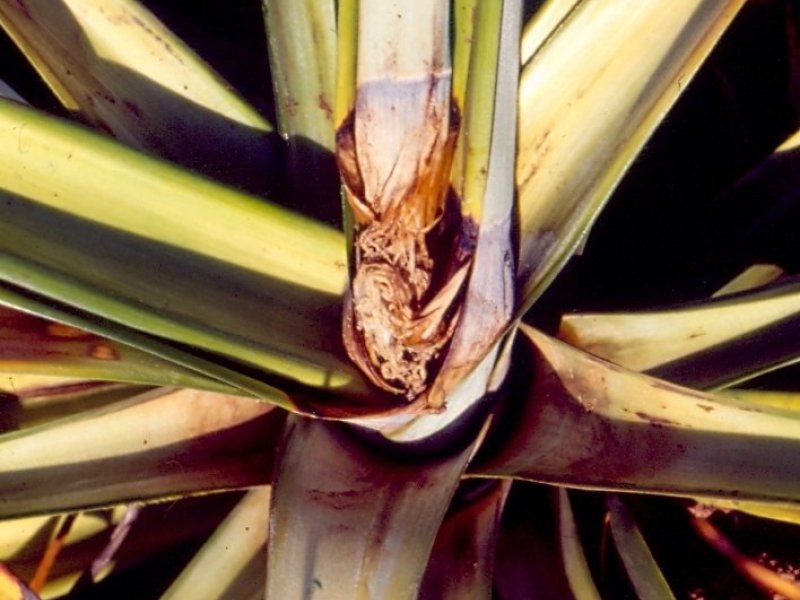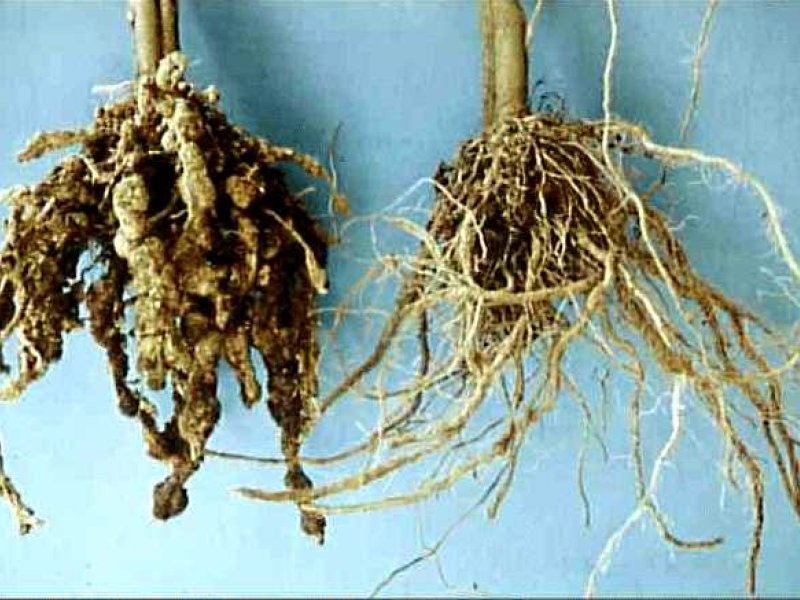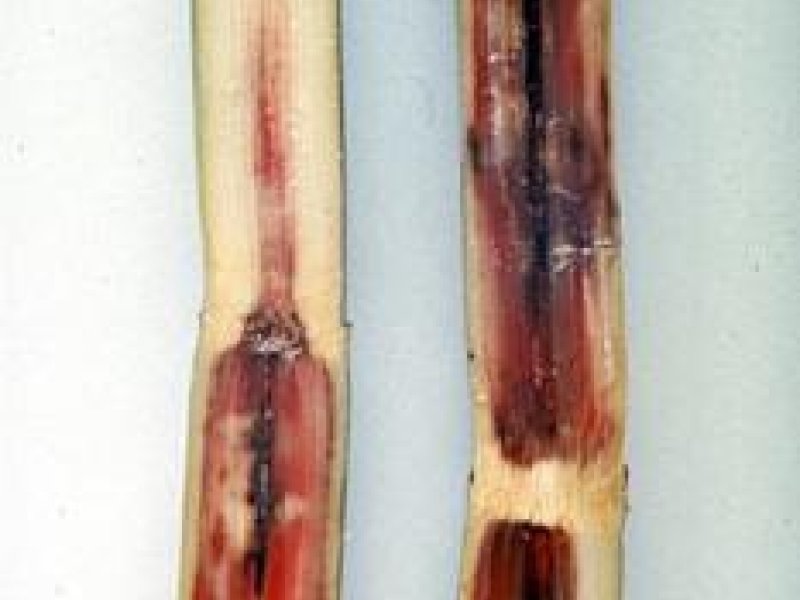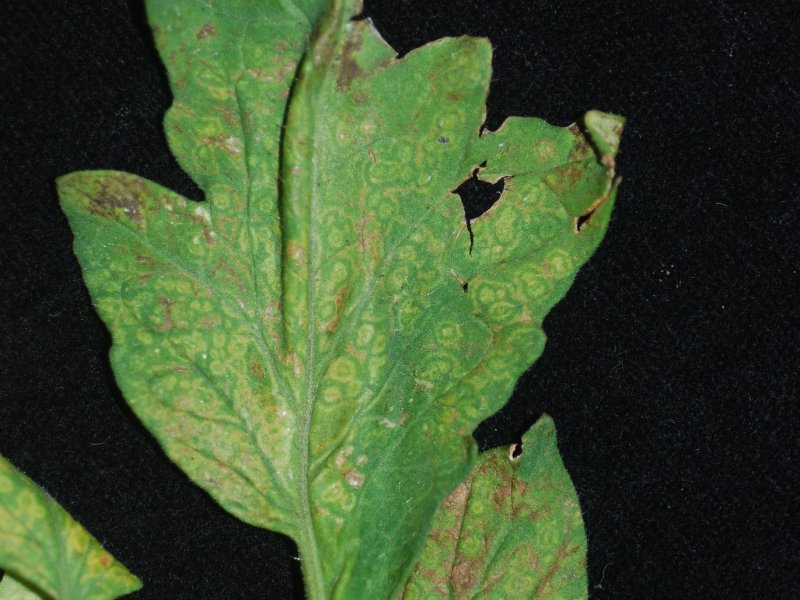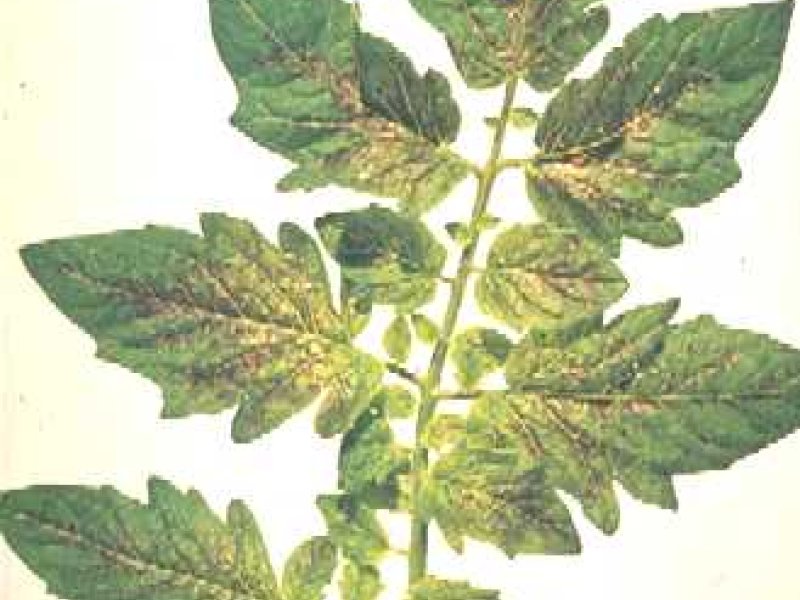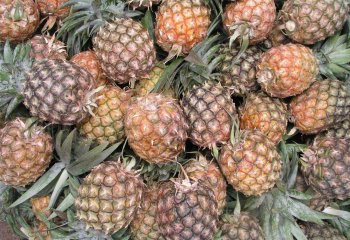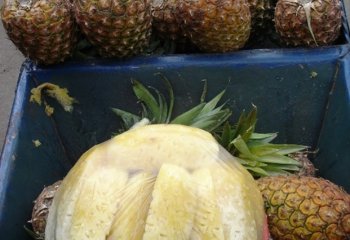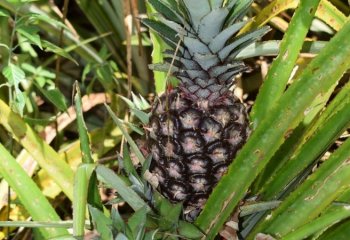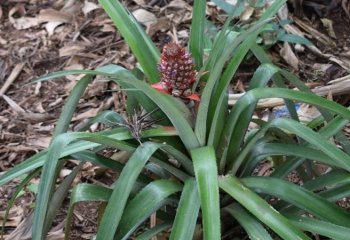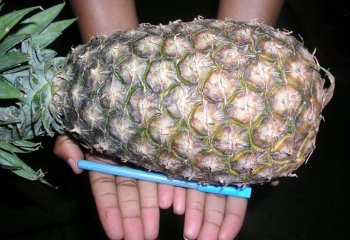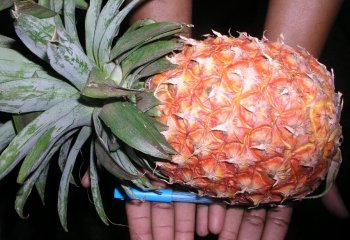|
Mealybug or pineapple wilt virus Infected plants become yellowish-red to bright red at the leaf tips, this colouration spreading down the leaf with time. Soon other leaves turn colour and also show signs of wilting. However, the inner heartleaves remain normal. Severely infected plants become stunted and produce small, undergrade and immature fruits. The first effect of the disease usually appears in the roots, which stop growing, collapse and then rot; this results in leaves symptoms similar to the effect of drought. The root system collapses and rots before the first leaf symptoms appear. The disease is probably introduced with planting material, which may not show obvious disease symptoms. Once established, it is spread by mealybugs, sedentary insects, which are moved from plant to plant by attendant ants. The mealybugs are found at the base of leaves, moving on to healthy plants once their host starts to wilt. Warm weather favours the build-up of mealybugs and this is when most serious outbreaks of the disease occur. Plants growing vigorously as on virgin land and well-fertilised soil (especially with nitrogen fertiliser) appear to be more resistant to wilt. Adverse growing conditions increase the susceptibility of plants to wilt. Plants may recover from wilt to different degrees, depending on the extent of the wilt and the age of the plant at the time of wilting; younger plants stand a better chance of recovery. Older plants are less susceptible than younger plants, and slips and suckers less susceptible than the mother plant on which they are borne.
|
|
|
What to do:
|
|
Pineapple mealybug (Dysmicoccus brevipes) The mealybugs are oval, pink in colour, up to 3 mm long, covered with a whitish waxy secretion, which develops into waxy filaments around the body. This mealybug is the most serious pest of pineapples, because it is a vector of the Mealybug or Pineapple Wilt Virus. The mealybug is common on the roots of pineapple and large colonies develop on the stems just above ground level.
The mealybugs may spread upwards to feed in the floral cavities, on both small and mature fruit, and on the crown leaves. Heavy infestations are conspicuous because of the white waxy adults, which often occur at the growing points, around the stem nodes, on the undersides of leaves, on the fruit and on the roots.
Feeding on leaves causes yellowing and drying up of the leaf-tips, which progresses towards the base of the leaves. Feeding in the blossom cavities causes wounds, which sometimes become contaminated by fungal spores resulting in a disorder called black spot. Feeding on roots is associated with the rotting of roots and subsequent wilting of the plant. "Smooth Cayenne" crowns used as planting material are frequently infested with mealybugs, and therefore new plantations usually become infested from the time of planting.
The bigheaded ant, Pheidole megacephala, is commonly associated with mealybug colonies. They do not attack the mealybugs but feed on the honeydew excreted by the mealybugs, preventing the formation of thick honeydew coats where crawlers (young mealybugs) may get entangled. Moreover, while feeding on honeydew, the ants interfere with the mealybug natural enemies. Thus, mealybug colonies thrive in presence of ants. Mealybug infestations may also be spread into new plantings by ants carrying the young mealybugs from one plant to another in their jaws.
|
|
|
What to do:
|
|
Pineapple top and root rot (Phytophtora cinnamomi and P. nicotianae var. parasitica) Top rot initially manifests in a colour change of heart leaves from green to yellow or light-brown with a red tinge. The leaf edges curve back and leaves are easily pulled out from the plant. Internally, the stem and leaf bases become soft, rotten and have an unpleasant smell. The growing point of the stem has a cheese-like appearance. Root rot causes similar symptoms like top rot. However, the outer leaves become limp and dieback from the tips. By this stage, the root system has rotten and plants can be easily pulled from the ground. Rot rot often extends through the stem to cause top rot. Fruits from diseased plants are normally small and are not marketable. Both P. cinnamomi and P. nicotianae var. parasitica are soil inhabitants and require water for spore production and infection. These fungi prefer wet soil conditions.
|
|
|
What to do:
|
|
Nematodes (Meloidogyne javanica and Pratylenchus brachyurus) Root-knot nematodes (Meloidogyne javanica) cause distinct swellings (galls/knots) on the roots. The root lesion nematodes (Pratylenchus brachyurus) develop brown lesions (spots) on the roots, which may girdle the roots and cause their premature death.
|
|
|
What to do:
|
|
Thrips (Thrips tabaci and Frankliniella schultzei ) Thrips are small (1.5 mm long), slender, brown insects with pale yellow hind wings that appear as a yellow line down the back of the body when the insect is at rest. Adult thrips have characteristic wings; the transparent wings have a fringe of hairs around the outside edge standing out in the same plane as the wing.
The onion thrips (Thrips tabaci) and the blossom or cotton bud thrips (Frankliniella schultzei) are considered important pests of pineapples because they are vectors of the yellow spot virus, which have been shown to be identical to the tomato spotted wilt virus. The blossom thrips feeds mainly on flowers and its feeding results in the development of "dead-eye" in the fruit. Thrips feeding on the crown of fruits results in concentric ring patterns developing on crown leaves. |
|
|
What to do:
|
|
White leaf spot (Ceratocystis paradoxa, Thielaviopsis paradoxa) The fungus Ceratocystis paradoxa causes white leaf spot, black rot, base or but rot and soft rot or water blisters. White leaf spots are yellow to brown and several centimetres long. Later they dry to become papery and straw coloured. Base or but rot of pineapple is a common disease of crowns, slips and suckers used for establishing new plantings. Rot of planting material occurs when they are not dried and are packed with little aeration. The fungus also destroys older plants by entering through wounds caused in the collar region while weeding or other field operations. In severe conditions the entire plant may turn dark and rot within 2 or 3 days. Black rot is a post-harvest disease occurring only on injured pineapple fruit. Only freshly cut or injured tissue is infected, and a soft black rot with dark coloured mycelium develops. Water blisters consist of a soft, watery rot of the fruit flesh with overlying skin glassy, water-soaked and brittle. Eventually, the skin, flesh and core disintegrate and the fruit dries out, leaving an empty fruit carcass containing a few, black vascular fibres. The fungus enters the fruit through wounds and the crevices between individual fruits.
|
|
|
What to do:
|
|
Yellow spot virus The yellow spot virus has been shown to be identical to the tomato spotted wilt virus. It infects over a 100 species of plants including peppers, tomato, tobacco, eggplant, potato, broad bean, spinach, chicory and peas. A number of wild plants, including some common weeds such as the black jack (Bidens pilosa), Emilia sonchifolia and Datura stramonium, are also host of this virus. Thrips are vectors of this virus. When host plants of the virus are grown near to pineapple plants, the incidence of the yellow spot virus is considerably enhanced due to thrips migrating into the pineapple field. Wind carries thrips long distances and thus also plays an important role in the transmission of the virus. One of the symptoms in the fruit is a blackened, dry cavity in the side of the fruit due to one or more "eyes" having died. This is known as "dead eye". Infection of very young fruit results in an irregular arrangement of fruitlets as some fail to develop. Attacked fruits may also fail to develop a crown. Thrips feeding on the crown of fruits results in concentric ring patterns developing on crown leaves. These spots enlarge and the infection spreads into the fruit itself, by which time the crown will often have dried out. The flesh of fruits thus infected will be discoloured and necrotic below the butt of the crown. The whole fruit may eventually become affected.
|
|
|
What to do:
|
Geographical Distribution in Africa
Geographical distribution of Pineapple in Africa. Updated on 8th July 2019. Source FAOSTAT.
© OpenStreetMap contributors, © OpenMapTiles, GBIF. https://www.gbif.org/species/5288819.
Ananas comosus, traces its origin to South America, particularly the region encompassing present-day Brazil, Paraguay, and Argentina. Historically, indigenous populations cherished its sweet fruit. Columbus first encountered the pineapple in 1493 on Guadeloupe, naming it "piña de Indes" and carrying it to Europe, marking the fruit's inaugural journey from the New World.
The Spanish propagated the pineapple's spread, introducing it to far-flung lands such as the Philippines, Hawaii (with the first commercial plantation in 1886), Zimbabwe, and Guam. Portuguese influence led to its introduction in India by 1550. Throughout the 16th century, Portuguese and Spanish explorers brought the pineapple to their colonies across Asia, Africa, and the South Pacific, where it still thrives today. Its scarcity and high value in those times elevated its status. Portuguese traders are said to have introduced pineapple into the east and west coasts of Africa.
The 18th century witnessed pineapple cultivation taking root in Hawaii, eventually emerging as a major producer. This trend extended globally, encompassing nations like Thailand, the Philippines, China, Brazil, and Mexico.
(GBIF secretariat, 2021, THE WORLDWIDE VEGETABLES, 2015, Kew botanical gardens (n.d))
Further information on geographical distribution: https://powo.science.kew.org/taxon/urn:lsid:ipni.org:names:12322-2
Read more
Local Names (Detailed)
Angola: Ananas, Abacasi (Portuguese)
Burkina Faso: Anana tiiya
DRC: Mampura-Mpuru (Kiyanzi); Nanazi (Kikongo); Ananasi (Lonkundo); Langa (Ngbandi)
Gabon: Ngubi (Apindji, Dilanga (Bahumbu); Difubu (Balumbu, Eshira); Iba (Banzabi); Iguwu (Galoa, Mpongwé), Nkoc-Nsèc, Nkuba (Fang); Ikoko-Ny'atanga (Nkomi); Ananas (French) ; Mokodi / Mikodi (Babongo)
Ghana: Blefo nmer (Adangbe); Abrobe (Twi dialect)
Guinea Conakry: Kwito
Ivory coast: Abliblé (Aslianti, Agni)
Kenya: Nanasi (Swahili)
Mauritius: Ananas (Creole), Anas (Taboul); Zanana (Mauritian Creol And Bhojpuri)
Madagascar: Mananasy (Antakarana); Fandra, Satra (Malgache); Ananas (French)
Nigeria: Ope Oyinbo (Yoruba); Akwumbe/Akwu-Olu (Igbo); Nkwu Aba/Abara (Hausa); Ope-Oyinbo, Ehin-Ahun, Ekukkun (Okeigbo)
Togo: Atoto (African museums).
Uganda: Enanasi (Runyankole, Rukonjo, Runyaruguru)
General Information and Agronomic Aspects
Introduction
Pineapple (Ananas comosus) is a tropical fruit that belongs to the family Bromeliaceae and the genus Ananas. The family Bromeliaceae encompasses a wide array of plants, many of which are native to tropical and subtropical regions. The genus Ananas consists of several species, but the most well-known and widely cultivated species is A. comosus.
Ⓒ Adeka et al., 2005. Foods of Nairobi people
The pineapple is native to South America, likely in the region encompassing Brazil, Paraguay, and northern Argentina. The plant is now widely grown throughout the tropics and in warm locations in the subtropics, and it is also grown in heated greenhouses in temperate countries. Pineapple thrives in warm climates with well-draining soil and adequate sunlight. Portuguese traders are said to have introduced pineapple into the east and west coasts of Africa. Pineapples in Kenya are mainly grown in Thika, Malindi and Kisii.
Pineapple is grown for its fruit that is eaten fresh, as dessert, in salads; processed into juice, jam, dried fruits, preserves (crystallised and glace fruit); cooked in pies, cakes, puddings; or used in sauces.
ⒸAdeka et al., 2005. Foods of Nairobi people
Pineapple juice, canned pineapple slices, spirals and dried pineapple are common processed forms. Additionally, pineapple enzymes, like bromelain, find application in tenderizing meat, dietary supplements, and skincare products. The by-products of canning can be used as cattle feed or to produce pineapple wine or vinegar. The plant's leaves serve as a valuable resource for producing a strong, white, soft, and flexible fiber with a lengthy staple. The fibers are woven into a fine cloth in the Philippines and Taiwan.
Pineapple is a rich source of essential nutrients and vitamins. It's particularly known for its high content of vitamin C, which is important for immune health and collagen production. Pineapple also contains dietary fiber, manganese, and vitamins like B6 and B9 (folate). Moreover, pineapple enzymes, such as bromelain, have been studied for their potential health benefits, including anti-inflammatory properties.
In its unripe state, the fruit enhances digestion, stimulates appetite, alleviates dyspepsia, and soothes sore throats. When the fruit ripens, it aids in decreasing excessive gastric acid. Moreover, its substantial fiber content makes it useful as a natural laxative for relieving constipation. Extracted juice from ripe fruits acts as a diuretic and digestive aid, also being applied externally to burns, itchy skin, and boils. The leaves are employed in the treatment of fractures and to alleviate menstrual pain.
Pineapple is a sought-after fruit in the global market, with significant producers including countries like Costa Rica, the Philippines, Thailand, and Brazil. These countries leverage their tropical climates to cultivate and export pineapples to various parts of the world. In Africa, countries like Nigeria, Ghana, and Ivory Coast are key pineapple producers, contributing to both local consumption and international trade.
(Plant village (n.d), The Worldwide Vegetables, 2015).
Species account
A. comosus, is an herbaceous biennial or perennial plant which grows to a height of 1.0 to 1.8 m although sometimes it can be taller. Stems: stout stem and a rosette of sword-shaped leaves with needle-like tips. Leaves: waxy, with upturned spines on the margin, may be solid green or striped with red, white or cream. When the plant flowers, the stem begins to elongate and produces a flower head of small purple or red flowers, each with a pointed bract. The stem continues to elongate and sets down a tuft of short leaves called a 'crown'. Individual fruits develop from the flowers and fuse to form one large cylindrical fruit topped by the crown. Fruit: has a tough rind made up of hexagonal units and a fibrous, juicy flesh which may be yellow to white in color.
(Plant village (n.d)
© Muia J, 2021
© Muia J, 2021
ⒸAdeka et al., 2005. Foods of Nairobi people
Pineapple Varieties
Pineapples exhibit a range of variations, including exterior colors from yellow to orange, diverse flesh textures, varying sizes, and nuanced flavor profiles of tangy sweetness. Some Ananas species are grown as ornamentals for color, novel fruit size and other esthetic qualities.
Some of the key species cultivated across the world include:
•Smooth Cayenne: Weighs 2.5-3 kg, pale to yellow flesh. Cylindrical shape, high sugar and acid content. Great for canning and processing. No spines on leaves. An old type now replaced by 'MD-2'. It is one of the ancestors of cultivars '73-114' (also called 'MD-2') and '73-50' (also called 'MD-1' and 'CO-2'). The most important variety "Smooth Cayenne" is grown commercially in Kenya for both canning and the fresh market.
•Hilo Pineapple: A small Hawaiian type, weighing 1-1.5 kg. Cylindrical shape, many suckers but no slips.
•Kona Sugarloaf: Weighs 2.5-3 kg, with white flesh. Sweet and no acidity, very sugary.
•Natal Queen: Weighs 1-1.5 kg, golden yellow flesh, crisp and mildly flavored. Good for fresh eating and storage.
•Pernambuco (Eleuthera): Weighs 1-2 kg, pale yellow to white flesh. Sweet and great for eating fresh but not suitable for shipping, spiny leaves, grown in Latin America
•Red Spanish: Weighs 1-2 kg, pale yellow flesh with a nice aroma. Square shape, good for shipping to distant markets.
More pineapple cultivars exist at regional level resulting from intentional breeding to suit them to varied ecological conditions and market preference. Different names are assigned to the varied cultivars.
Smooth Cayenne is the most commonly grown worldwide for both canning and the fresh market.
(THE WORLDWIDE VEGETABLES, 2015)
Ⓒ Foods of Nairobi people, 2005
Ⓒ Adeka et al., 2005. Foods of Nairobi people
Ⓒ Adeka et al., 2005. Foods of Nairobi people
Ecological conditions
Pineapple is grown successfully in tropical lowlands and in the subtropics, in areas where the climate is warm, humid and free from extreme temperatures. A temperature range of 18 to 45°C is favourable, 25 °C being optimal, though the plant can tolerate cool nights for short periods. Prolonged cold retards growth, delays maturity and causes the fruit to be more acid. Temperatures below 20°C can lead to chlorotic discolouration, so, away from tropics, the right combination of heat and moisture are important factors to consider for successful pineapple production.
Very intensive solar radiation can damage the fruit. Under the full strength of the sun the fruits can develop sunburn, especially when they lodge and are no longer protected by the crown. One method of protection in these cases is binding the leaves around the fruits in order to cover them. However, this is the labour-intensive. Alternatively, the crop can be dusted with lime or diatomite to leave a thin layer of reflecting substance on the fruits/plants.
Pineapple will produce fruit under annual precipitation ranging from 650 to 3,800 mm depending on cultivar, location and atmospheric humidity (RH should range between 70 and 80%). Ideal rainfall for pineapple production is about 1,100 mm. Reasonable yields can be obtained with as little as 750 mm of well-distributed rainfall per year or with supplementary irrigation (600 mm and 2500 mm being the outer limits). Irrigation is essential right after planting unless this is done during the rainy season. After establishment, irrigation is only necessary when long dry periods occur. Overhead or drip irrigation is recommended and flood irrigation should be avoided. Pineapples cannot stand waterlogging.
In Kenya pineapples grow well from sea level up to 2000 m. Altitude has an important effect on the flavour of the fruit; above 1800 m they become increasingly sour and acidic.
The best soil for pineapple culture is a well-drained, sandy loam with a high content of organic matter and it should be friable for a depth of at least 60 cm. The crop does well on optimum pH of 4-5. Soils with old ant hills have a higher pH, and are not suitable for the production of good pineapples. Avoid black cotton soil, low lying areas and common red loams that are likely to flood.
Agronomic aspects
Land preparation
The land should be well prepared before planting because pineapple is shallow-rooted and easily damaged by post-planting cultivation. Proper land preparation is extremely important for the development of the roots. Poor land preparation result in poor yields. Perennial weeds should be cleared by repeated deep cultivations during the dry season. Uproot weeds (e.g. couch grass (I sp.), allow them to dry, harrow into strips and burn them.
In areas where the soils have high clay content, it is essential to plough also during the dry season to facilitate root penetration of pineapples. Plough to a depth of 45 cm, or if using hand digging, dig as deep as possible. After ploughing, use a disc harrow to produce a fine tilth.
Small-scale growers can uproot old pineapple plants by hand, while large growers can use a large harrow to uproot and chop the stumps and leaves.
Manures and fertilisers
Nitrogen is essential to increase fruit size and total yield. Five to 10 tons of manure per hectare applied to the field before mulching and planting will increase eventual yields. A general application of 180 to 200 kg/ ha of rock phosphate should be added at the same time. Each ratoon crop will again need a new supply of nutrients and will benefit from compost as well as rock phosphate at the same rate.
If legumes are used as green cover plants, it should be considered that they supply significant amounts of nitrogen to the soil when calculating the amounts of compost required. In this case, compost with a rather high C/N ratio should be used. If possible, the compost should be spread in two separate lots: one half (about 2.5 tons) before planting, and about 2.5 tons to induce flower formation. Organic foliar feed is also beneficial. However too much nitrogen will result in watery/ glassy fruit as well as in production of multiple crowns on fruits and too many slips. Deficits in the potassium supply can be balanced out by the use of wood ash (combined with compost). In exceptional cases, the certification bodies will allow the use of potassium magnesia inorganic farming.
No fertilisation should take place after the first bud stage.
Crop rotation
Crop rotation should be followed allowing several years between pineapple crops on the same land. Some crops usually included in rotation with pineapples are groundnuts, beans, rice and vegetables. To prepare the land used for pineapple production,green manure plants like cowpea, can be grown and incorporated into the soil prior to planting pineapples.
Crop rotation is important to avoid build-up of root knot and other nematodes that contribute to large crop losses. To be effective, crops known to reduce or eliminate root knot nematode infestation should be planted between pineapple crops. See also biofumigation
For more information on root-knot nematodes click here
Mulching
Use of black polythene (150 gauge) is recommended as it helps maintain high soil temperature, retain moisture and controls weeds to some extent. In areas where temperatures are high, use of mulch may not be essential. Use of grass mulch has been found to reduce yields.
Propagation and planting
Commercial propagation of pineapple is not through seeds but by vegetative propagation. Three types of planting material are used for pineapple growing. These are crowns, slips and suckers.
- Crowns are the leafy growth on top of the fruit. In Thika these take 25-28 months to come into bearing, but have uniform growth and are less susceptible to premature fruiting.
- Slips are leafy shoot growth arising from the fruit stalks. They take 22-24 months to come into bearing.
- Suckers are leafy shoot growth from the base of the plant where the roots grow. They give the highest yield, but take long to fruit production. They are also more difficult to plant. Suckers take 18-22 months to come into bearing.
To achieve uniform plant growth, selection and sizing of planting material is of major importance.
All planting material can be stored upside down (to promote suberisation and avoid rotting) in the shade for up to three months and then planted in loose friable dry or pre irrigated soil. Only totally healthy and if possible large shoots should be chosen (about 400 to 500 g in weight are best), in order to ensure a uniform crop.
Slips can also tolerate dryness, yet not as well as the suckers as they are generally lighter in weight. Slips vary much in size making grading in sizes necessary in order to have uniform plantings.
Rapid multiplication
If there is shortage of planting material, each type of planting material can be split vertically into 2 or 4 sections with a bit of root section, suberised and planted into irrigated nurseries at very close spacing. They can then produce new plantlets in 3 to 4 months time.
To avoid infection by dry-rot fungus all of the shoots should be stored in a shady place for wounds to heal and suberise quickly. Take care that no mealybugs are present in the shoots or on the leaf blades.
No soil should remain on the shoots to prevent infection by soil-borne fungi such as e.g. Phytophthoraspp. and/or nematodes. Hot water treatment (50°C for 30 minutes to two hours) of planting material is efficient and can control both mealybugs,Phytophthora and nematodes. After this treatment it is important to drip-dry the planting material to avoid fungal attack and deterioration.
Planting is normally done at the beginning of the long rains.
Spacing
Spacing depends on cropping pattern chosen. For monocropping where irrigation is available a plant population of 70,000 to 100,000 plants/ha is possible. This can be achieved by planting double rows 40 cm apart, 60 cm between the double rows, and 20 cm between plants. This can give a yield of 100 to 120 t/ha plus about 40 t/ha for the ratoon crop. Under rain-fed conditions spacing between double rows is increased to double rows 60 cm apart and 90 cm between the double rows and 30 cm between plants. This spacing can yield about 75 t/ha plus 30 t/ha in the first ratoon.
In intercropping the same double rows can be used and interplanted with legumes and/or cereals. The intercropped area and the pineapple area can then switch location when pineapples need replanting. Intercropped legumes help provide nitrogen to the pineapple crop.
(From "Fruits and Vegetables Technical Handbook")
Flower induction
Pineapple flowering may be delayed or uneven, and it is highly desirable to attain uniform maturity and also to control the time of harvest in order to avoid overproduction in the peak periods. Synchronised flowering can be induced by smoke (due to ethylene produced). Ethylene and ethylene-releasing compounds (e.g. Calcium carbide) used in conventional production are very effective. Flower formation in agroforestry systems can be induced by selective tilling of the weeds and by cutting back trees two months before the blossoming is supposed to occur. The sudden increase of light will have a similar effect to using carbide. This enables the harvesting time to be controlled in response to market demand (e.g. before or after the usual regional harvesting season to gain a price advantage).
Harvest, post-harvest practices and markets
The fruits are ready to harvest when they snap off at the bending of the fruit. Fresh fruits destined for the local market are plucked when almost ripe. Fresh pineapples destined for export are harvested green-ripe (beginning to turn yellow-green at the base of the fruit). They are cut off with a sharp knife leaving a stem which is later trimmed to 3.4 cm.
Fruits can then be cool-stored for up to four weeks (storage temperature about 7°C). Because of their low sugar-content, pineapples harvested too early are unpopular amongst consumers (unripe pineapples do not ripen after harvest). The colour of the skin is an important criterion in determining the ripeness of the fruit. Fruits destined for the European market are often classified according to the extent to which an orange-yellow colouring has spread up from the base of the fruit as follows:
- Ripeness-colour 1: Only the base is orange-yellow.
- Ripeness-colour 2: The orange- yellow colour covers half of the fruit.
- Ripeness-colour 3: The orange- yellow colour reaches three quarter up.
- Ripeness-colour 4: Whole of the fruit yellow.
Only fruits of ripeness-colour 1 can be exported.
Every care should be taken to prevent bruising. Pineapples should not be thrown into lorries as this will cause bruising.
For canning the sugar/acid ratio (°Brix) is measured and the fruit is graded according to sizes. 13 to 16° Brix is suitable for canning. This is only attainable when the fruits mature when there is plenty of sunshine.The graded sizes are based on the diameter of the fruit as follows:
- Grade I - 12.7 cm minimum diameter and 15.3 cm minimum length (about 3 ½ kg fruit)
- Grade II - 10.8cm minimum diameter and 13.3 cm minimum length (2 ½ - 3 kg fruit)
- Grade III: 8.9 cm minimum diameter and 11.4 cm minimum length (1 ½ - 2 kg fruit)
Canneries accept only grade I and II.
Pruning
Once the fruit has been harvested, remove all slips and leave generally only 1 (maximum 2) strong and healthy sucker arising from ground level. Leaving more suckers will reduce the size of harvested fruits. The rest of the slips and suckers can be used as additional planting material after sorting or can be chopped and used as mulch. The mother plant can be left in the field as mulch.
Ratoon crop
The yields of ratoon crops are much lower than of the planted crop, so generally only one ratoon crop is economical. A second and third ratoon crop are possible under small scale conditions where the crop is interplanted with other crops, and fertilised well, provided there is no mealybug infestation. Once this has been harvested, all plants need to be dug up and the land prepared for rotation crops.
Planting methods and cultivation systems in organic farming:
In the majority of organic plantations, pineapples are planted together with other crops either in agroforestry or mixed crop systems. Examples exist where pineapples are planted as a rotation-fruit with green fallow land and other crops. The farm plan will depend upon which cultivation form is adopted (agroforestry system, mixed crops as a bottom culture, crop-rotation etc.).
Pineapples are an excellent choice to plant for a limited time on young agroforestry systems. Pineapples as well as papaya are well suited as so-called "nursery crops" to raise trees. Yet, they are less demanding regarding soil fertility. Pineapple plants require a lot of light; they will not produce saleable fruit if grown in the shade. Therefore, they should be planted away from the canopy of trees in an agroforestry system. Pineapples planted in diverse agroforestry systems will usually have no need to be supplied with external, organic fertiliser. The less varieties an agroforestry system contains (especially when leguminous trees are lacking), the more the soil will need to be fertilised with compost (or an undergrowth of soil-covering legumes).
Pineapples are easy to combine with other crops as a bottom crop. In particular: coffee, cocoa, coconut, cashew, coconut and date palms, avocado and mango. In diverse agroforestry systems, crop rotation is unnecessary. However, if pineapples are planted as bottom crops in a mixed system, e.g. with oil or date palms, then the crop rotation methods mentioned above must be adhered to in order to avoid a build up of pests and a decline of the soil fertility.
As soon as the plantation begins to produce fruit, any harvested plants should be removed and cut up before being spread over the soil. The plantation will also need to be thinned out from time to time, because suckers, which continually develop, may limit the amount of room available for each individual plant.
Tilling weeds is neither possible nor desirable in agroforestry systems. When all possible niches are already occupied with plants, weeds will have little chance of gaining a foothold, and can also easily be uprooted by hand. Mature weeds can be cut down with a knife or pulled out and then cut up to be used for mulch material. One preventative measure is to sow non-climbing legumes before the pineapples are planted (e.g. Pueraria ssp, but Purearia phaseoloides develops strong tendrils, and is not suitable for pineapples. Some Vigna ssp. among others) can be used. Usually, this bottom culture will suppress the growth of weeds. Depending upon the amount of water available, when enough weeds have accumulated, these can be cut down and used as mulching material.
Nutritional value
Pineapple is a versatile tropical fruit packed with minerals, bioactive compounds, antioxidants and other useful compounds such as enzymes. The fruit is low in calories and fa making it a good option for calorie conscious persons. The natural sugars present in pineapples are accompanied by a generous serving of water, enhancing hydration and making it a refreshing choice during warm weather.
Pineapples contain trace amounts of phosphorus, zinc, calcium, Vitamin A and K. The mineral manganese, albeit required in smaller amounts, is also present in pineapples and contributes to bone health, antioxidant defense, and proper metabolic function. Consuming pineapple as part of a balanced diet can contribute to meeting daily manganese requirements.
Pineapples offer a significant amount of vitamin C, a potent antioxidant that aids in bolstering immune system, promoting skin health, and facilitating wound healing. A serving of this tropical fruit can provide a substantial portion of the recommended daily intake of vitamin C, helping to defend the body against harmful free radicals and reducing the risk of chronic diseases.
Moreover, pineapples contain a remarkable enzyme known as bromelain, which possesses anti-inflammatory and digestive properties. Bromelain assists in breaking down proteins, aiding digestion and potentially alleviating digestive discomfort. Additionally, the anti-inflammatory properties of bromelain may contribute to reduced inflammation in the body, offering potential relief to those with conditions like arthritis. Fiber, another valuable component found in pineapples, plays a pivotal role in maintaining a healthy digestive system. Fiber promotes regular bowel movements, helps prevent constipation, and supports gut health by providing nourishment to beneficial gut bacteria.
(Healthline (n.d), Wedmd (n.d)
Further reading:
• https://www.healthline.com/nutrition/benefits-of-pineapple
• https://www.webmd.com/diet/ss/slideshow-health-benefits-pineapple
Table 1: Proximate nutritional value per 100g of edible portion
Code Food Name |
Pineapple, raw |
Pineapple, canned in syrup, whole contents |
Recommended daily allowance (approx.) for adults a |
Edible conversion factor |
0.68 |
1 |
|
Energy (kJ) |
172 |
393 |
9623 |
Energy (kcal) |
41 |
93 |
2300 |
Water (g) |
88.6 |
77 |
2000-3000c |
Protein (g) |
0.48 |
0.3 |
50 |
Fat (g) |
[0.2] |
0.6 |
<30 (male), <20 (female)b |
Carbohydrate available (g) |
8.1 |
21.2 |
225 -325g |
Fibre (g) |
2.3 |
0.7 |
30d |
Ash (g) |
0.3 |
0.2 |
|
Minerals |
|||
Ca (mg) |
16 |
4 |
800 |
Fe (mg) |
0.4 |
0.4 |
14 |
Mg (mg) |
13 |
11 |
300 |
P (mg) |
8 |
3 |
800 |
K (mg) |
143 |
80 |
4,700f |
Na (mg) |
1 |
6 |
<2300e |
Zn (mg) |
0.37 |
0 |
15 |
Se (mcg) |
1 |
1 |
30 |
Bioctive compounds. |
|||
Vit A RAE (mcg) |
3 |
1 |
800 |
Vit A RE (mcg) |
5 |
1 |
800 |
Retinol (mcg) |
0 |
0 |
1000 |
b-carotene |
31 |
8 |
600 – 1500g |
Thiamin (mg) |
0.05 |
0.05 |
1.4 |
Riboflavin (mg) |
0.03 |
0 |
1.6 |
Niacin (mg) |
0.12 |
0 |
18 |
Dietary Folate Eq. (mcg) |
32 |
5 |
400f |
Food folate (mcg) |
32 |
5 |
400f |
Vit B12 (mg) |
0 |
0 |
3 |
Vit C (mg) |
36.4 |
9 |
60 |
Source (Nutrient data): FAO/Government of Kenya. 2018. Kenya Food Composition Tables. Nairobi, 254 pp. http://www.fao.org/3/I9120EN/i9120en.pdf
RE=retinol equivalents.
RAE =Retinol activity equivalents. A RAE is defined as 1μg all-trans-retinol, 12μg beta-carotene, or 24μg α-carotene or β-cryptoxanthin.
a Lewis, J. 2019. Codex nutrient reference values. Rome. FAO and WHO
b NHS (refers to saturated fat)
c https://www.hsph.harvard.edu/nutritionsource/water/
d British Heart Foundation
e FDA
f NIH
g Mayo Clinic
Nutritive Value per 100 g of edible Portion
| Raw or Cooked Pineapple | Food Energy (Calories / %Daily Value*) |
Carbohydrates (g / %DV) |
Fat (g / %DV) |
Protein (g / %DV) |
Calcium (g / %DV) |
Phosphorus (mg / %DV) |
Iron (mg / %DV) |
Potassium (mg / %DV) |
Vitamin A (I.U) |
Vitamin C (I.U) |
Vitamin B 6 (I.U) |
Vitamin B 12 (I.U) |
Thiamine (mg / %DV) |
Riboflavin (mg / %DV) |
Ash (g / %DV) |
| Pineapple raw | 50.0 / 2% | 13.1 / 4% | 0.1 / 0% | 0.5 / 1% | 13.0 / 1% | 8.0 / 1% | 0.3 / 2% | 109 / 3% | 58.0 IU / 1% | 47.8 / 80% | 0.1 / 6% | 0.0 / 0% | 0.1 / 5% | 0.0 / 2% | 0.2 |
*Percent Daily Values (DV) are based on a 2000 calorie diet. Your daily values may be higher or lower, depending on your calorie needs.
Information on Pests
General Information
Pineapples rarely suffer from pests when good growth conditions are prevalent. The following diseases and pests occur especially in systems which lack diversification.
Examples of Pineapple Pests and Organic Control Methods
| Nematodes (Meloidogyne javanica and Pratylenchus brachyurus) Root-knot nematodes (Meloidogyne javanica) cause distinct swellings (galls/knots) on the roots. The root lesion nematodes (Pratylenchus brachyurus) develop brown lesions (spots) on the roots, which may girdle the roots and cause their premature death.
What to do:
|
| Pineapple mealybug (Dysmicoccus brevipes) The mealybugs are oval, pink in colour, up to 3 mm long, covered with a whitish waxy secretion, which develops into waxy filaments around the body. This mealybug is the most serious pest of pineapples, because it is a vector of the Mealybug or Pineapple Wilt Virus. The mealybug is common on the roots of pineapple and large colonies develop on the stems just above ground level.
The mealybugs may spread upwards to feed in the floral cavities, on both small and mature fruit, and on the crown leaves. Heavy infestations are conspicuous because of the white waxy adults, which often occur at the growing points, around the stem nodes, on the undersides of leaves, on the fruit and on the roots.
Feeding on leaves causes yellowing and drying up of the leaf-tips, which progresses towards the base of the leaves. Feeding in the blossom cavities causes wounds, which sometimes become contaminated by fungal spores resulting in a disorder called black spot. Feeding on roots is associated with the rotting of roots and subsequent wilting of the plant. "Smooth Cayenne" crowns used as planting material are frequently infested with mealybugs, and therefore new plantations usually become infested from the time of planting.
The bigheaded ant, Pheidole megacephala, is commonly associated with mealybug colonies. They do not attack the mealybugs but feed on the honeydew excreted by the mealybugs, preventing the formation of thick honeydew coats where crawlers (young mealybugs) may get entangled. Moreover, while feeding on honeydew, the ants interfere with the mealybug natural enemies. Thus, mealybug colonies thrive in presence of ants. Mealybug infestations may also be spread into new plantings by ants carrying the young mealybugs from one plant to another in their jaws.
What to do:
|
| Thrips (Thrips tabaci and Frankliniella schultzei ) Thrips are small (1.5 mm long), slender, brown insects with pale yellow hind wings that appear as a yellow line down the back of the body when the insect is at rest. Adult thrips have characteristic wings; the transparent wings have a fringe of hairs around the outside edge standing out in the same plane as the wing.
The onion thrips (Thrips tabaci) and the blossom or cotton bud thrips (Frankliniella schultzei) are considered important pests of pineapples because they are vectors of the yellow spot virus, which have been shown to be identical to the tomato spotted wilt virus. The blossom thrips feeds mainly on flowers and its feeding results in the development of "dead-eye" in the fruit. Thrips feeding on the crown of fruits results in concentric ring patterns developing on crown leaves. What to do:
|
Information on Diseases
General Information:
Pineapples rarely suffer from diseases when good growth conditions are prevalent. The following diseases and pests occur especially in systems which lack diversification.
Examples of Pineapple Diseases and Organic Control Methods
| Pineapple top and root rot (Phytophtora cinnamomi and P. nicotianae var. parasitica) Top rot initially manifests in a colour change of heart leaves from green to yellow or light-brown with a red tinge. The leaf edges curve back and leaves are easily pulled out from the plant. Internally, the stem and leaf bases become soft, rotten and have an unpleasant smell. The growing point of the stem has a cheese-like appearance. Root rot causes similar symptoms like top rot. However, the outer leaves become limp and dieback from the tips. By this stage, the root system has rotten and plants can be easily pulled from the ground. Rot rot often extends through the stem to cause top rot. Fruits from diseased plants are normally small and are not marketable. Both P. cinnamomi and P. nicotianae var. parasitica are soil inhabitants and require water for spore production and infection. These fungi prefer wet soil conditions.
What to do:
|
| White leaf spot (Ceratocystis paradoxa, Thielaviopsis paradoxa) The fungus Ceratocystis paradoxa causes white leaf spot, black rot, base or but rot and soft rot or water blisters. White leaf spots are yellow to brown and several centimetres long. Later they dry to become papery and straw coloured. Base or but rot of pineapple is a common disease of crowns, slips and suckers used for establishing new plantings. Rot of planting material occurs when they are not dried and are packed with little aeration. The fungus also destroys older plants by entering through wounds caused in the collar region while weeding or other field operations. In severe conditions the entire plant may turn dark and rot within 2 or 3 days. Black rot is a post-harvest disease occurring only on injured pineapple fruit. Only freshly cut or injured tissue is infected, and a soft black rot with dark coloured mycelium develops. Water blisters consist of a soft, watery rot of the fruit flesh with overlying skin glassy, water-soaked and brittle. Eventually, the skin, flesh and core disintegrate and the fruit dries out, leaving an empty fruit carcass containing a few, black vascular fibres. The fungus enters the fruit through wounds and the crevices between individual fruits.
What to do:
|
| Mealybug or pineapple wilt virus Infected plants become yellowish-red to bright red at the leaf tips, this colouration spreading down the leaf with time. Soon other leaves turn colour and also show signs of wilting. However, the inner heartleaves remain normal. Severely infected plants become stunted and produce small, undergrade and immature fruits. The first effect of the disease usually appears in the roots, which stop growing, collapse and then rot; this results in leaves symptoms similar to the effect of drought. The root system collapses and rots before the first leaf symptoms appear. The disease is probably introduced with planting material, which may not show obvious disease symptoms. Once established, it is spread by mealybugs, sedentary insects, which are moved from plant to plant by attendant ants. The mealybugs are found at the base of leaves, moving on to healthy plants once their host starts to wilt. Warm weather favours the build-up of mealybugs and this is when most serious outbreaks of the disease occur. Plants growing vigorously as on virgin land and well-fertilised soil (especially with nitrogen fertiliser) appear to be more resistant to wilt. Adverse growing conditions increase the susceptibility of plants to wilt. Plants may recover from wilt to different degrees, depending on the extent of the wilt and the age of the plant at the time of wilting; younger plants stand a better chance of recovery. Older plants are less susceptible than younger plants, and slips and suckers less susceptible than the mother plant on which they are borne.
What to do:
|
| The yellow spot virus has been shown to be identical to the tomato spotted wilt virus. It infects over a 100 species of plants including peppers, tomato, tobacco, eggplant, potato, broad bean, spinach, chicory and peas. A number of wild plants, including some common weeds such as the black jack (Bidens pilosa), Emilia sonchifolia and Datura stramonium, are also host of this virus. Thrips are vectors of this virus. When host plants of the virus are grown near to pineapple plants, the incidence of the yellow spot virus is considerably enhanced due to thrips migrating into the pineapple field. Wind carries thrips long distances and thus also plays an important role in the transmission of the virus. One of the symptoms in the fruit is a blackened, dry cavity in the side of the fruit due to one or more "eyes" having died. This is known as "dead eye". Infection of very young fruit results in an irregular arrangement of fruitlets as some fail to develop. Attacked fruits may also fail to develop a crown. Thrips feeding on the crown of fruits results in concentric ring patterns developing on crown leaves. These spots enlarge and the infection spreads into the fruit itself, by which time the crown will often have dried out. The flesh of fruits thus infected will be discoloured and necrotic below the butt of the crown. The whole fruit may eventually become affected.
What to do:
|
References and information links
References
1.ARC-Institute for Tropical and Subtropical Crops (2000). Cultivation of pineapples. www.nda.agric.za.
2. Acland, J.D. (1980). East African Crops. An introduction to the production of field and plantation crops in Kenya, Tanzania and Uganda. FAO/Longman. ISBN: 0 582 60301 3
3.African Museums. Ananas comosus (L.) Merr.. https://www.africamuseum.be/en/research/collections_libraries/biology/prelude/view_plant?pi=01180&cat=&cur_page=4
4.Ananas comosus (L.) Merr. in GBIF Secretariat (2021). GBIF Backbone Taxonomy. Checklist dataset https://doi.org/10.15468/39omei accessed via GBIF.org on 2021-12-20.
5.Agricultural Information Centre, Nairobi (2003). Fruits and Vegetables Technical Handbook
6.CAB International (2005). Crop Protection Compendium, 2005 edition. Wallingford, UK www.cabi.org
7. Common Names of Diseases, The American Phytopathological Society.Retrieved from www.en.wikipedia.org
8. FICCI Agribusiness Information Centre India
9. Food Market Exchange (2002-2003). www.foodmarketexchange.com
10.Morton, J. (1987). Pineapple. p. 18?28. In: Fruits of warm climates. Julia F. Morton, Miami, FL. www.hort.purdue.edu
11.Personal interview with Dr. S. Nganga, former Head Superintendent, Founder of Research and Development at DelMonte, Kenya.
12.Petty, G. J. (1994). The pineapple mealybug. Institute for Tropical and Subtropical Crops, Nelspruit. H. 15/1994.
13. Ullman, D. E., Williams, D. F., Fleisch, H., Hu, J. S., Sether, D., Gonsalves, A. (1993). Heat treatment of pineapple: subsequent growth and occurrence of mealybug wilt of pineapple. Acta Horticulturae, 334:407-410.
Information links
• http://theworldwidevegetables.weebly.com/ananas-comosus-pineapple.html
• Pineapple organic cultivation guideline, 2001, Naturland. Available also online www.naturland.de/en/
• Nutrition Data www.nutritiondata.com.
Contacts information
• 1,817 active & genuine Pineapple flavour importers directory. https://www.volza.com/p/pineapple-flavour/buyers/
• Directory of Pineapple Importers. list of pineapple buyers, purchasers and buying agents looking to source pineapple from global suppliers. https://importer.tradeford.com/pineapple
• Kenyan Pineapple Suppliers and Manufacturers. https://www.go4worldbusiness.com/suppliers/kenya/pineapple.html
• Fresh Pineapple Suppliers in Kenya. https://www.food1.com/fresh-pineapple-suppliers/kenya
Review Process
Dr. Patrick Maundu, James Kioko, Charei Munene and Monique Hunziker, August 2024

